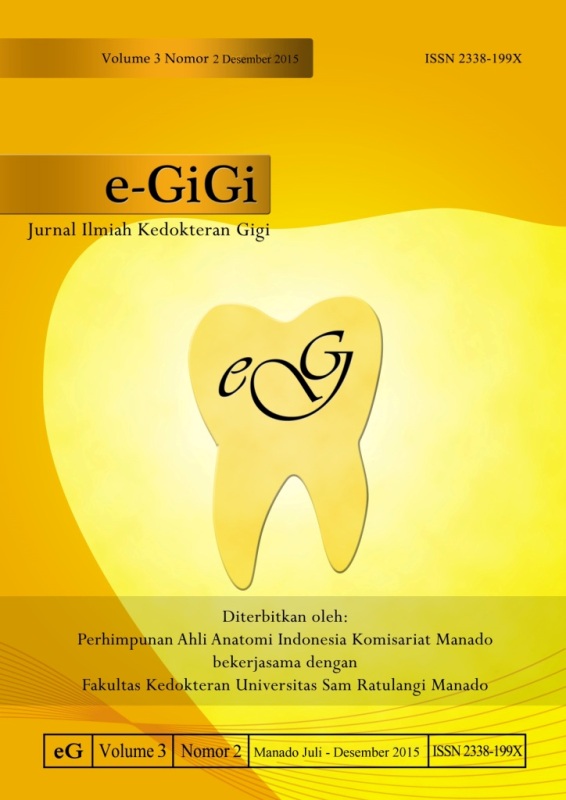PERBEDAAN KEKUATAN TRANSVERSAL BASIS RESIN AKRILIK POLIMERISASI PANAS PADA PERENDAMAN MUNUMAN BERALKOHOL DAN AQUADES
DOI:
https://doi.org/10.35790/eg.3.2.2015.9634Abstract
Abstract: Material denture base that is often used is the acrylic resin thermal polymerization. Thermal polymerized acrylic base material is easily fractured when it is knocked down and easily absorbs liquids such as alcohol. Consumption of alcohol increases the plasticization effects of materials through the process of diffusion and causes crazing in acrylic resin, thereforre, the resin acrylic becomes easily fractured. This study aimed to measure the lifetimes of objects against fracture and to measure the strength of transversal load maximum acceptable thermal polymerization of acrylic resin upon receiving pressure. This was a laboratory experimental study with a post test only control group design. The acrylic resin plate was used as sample of thermal polymerization with a size of 65x10x2.5 mm for testing the strength of the transversal load. There were a total of 32 samples consisting of 16 samples for groups soaked in liquor and 16 samples for groups soaked in aquades for 8 days. Each sample was tested for the strength of the transversal load. Data were analyzed with the independent sample t-test to find out the difference between transversal strength of the group soaked in alcohol and the group soaked in aquades. The results showed that the average strength of transversal groups soaked in liquor was 117.35N/mm2 and the average strength of groups soaked in aquades was 131.11N/mm2. Conclusion: There was a significant difference in the strength of the acrylic resin polymerization transversal thermal soaked in liquor and of that soaked in aquades (P value 0.007).
Keywords: alcoholic beverages, aquades, strength transversal
Abstrak: Bahan dasar basis gigi tiruan yang sering digunakan ialah resin akrilik polimerisasi panas. Bahan basis akrilik polimerisasi panas bersifat mudah patah bila terjatuh dan mudah menyerap cairan seperti alkohol. Alkohol yang dikonsumsi pengguna gigi tiruan menyebabkan meningkatkanya efek plasticization dari bahan melalui proses difusi dan menyebabkan crazing pada resin akrilik sehingga resin akrilik mudah fraktur. Untuk mengukur daya tahan benda terhadap fraktur maka dilakukan pengujian kekuatan transversal untuk mengukur beban maksimal yang dapat diterima resin arkilik polimerisasi panas pada saat menerima tekanan. Penelitian ini ialah eksperiman laboratoris dengan post test only control group design. Sampel ialah pelat resin akrilik polimerisasi panas dengan ukuran 65x10x2,5 mm. Jumlah total sampel sebanyak 32 yang terdiri dari 16 sampel untuk kelompok yang direndam dalam minuman beralkohol dan16 sampel untuk kelompok yang direndam dalam aquades selama 8 hari. Setiap sampel dilakukan pengujian kekuatan transversal kemudian dianalisis dengan uji independent sample t-test untuk mengetahui adanya perbedaan kekuatan transversal antara kelompok yang direndam dalam minuman beralkohol dan kelompok yang direndam dalam aquades. Hasil penelitian menunjukkan bahwa rerata kekuatan transversal kelompok yang direndam dalam minuman beralkohol yaitu 117,35 N/mm2 dan rerata kekuatan transversal keompok yang direndam dalam aquades yaitu 131,11 N/mm2.
Simpulan: Terdapat perbedaan bermakna antara kekuatan transversal resin akrilik polimerisasi panas yang direndam dalam minuman beralkohol dan yang direndam dalam aquades (P = 0,007).
Kata kunci: minuman beralkohol, aquades, kekuatan transversal
Downloads
How to Cite
Issue
Section
License
COPYRIGHT
Authors who publish with this journal agree to the following terms:
Authors hold their copyright and grant this journal the privilege of first publication, with the work simultaneously licensed under a Creative Commons Attribution License that permits others to impart the work with an acknowledgment of the work's origin and initial publication by this journal.
Authors can enter into separate or additional contractual arrangements for the non-exclusive distribution of the journal's published version of the work (for example, post it to an institutional repository or publish it in a book), with an acknowledgment of its underlying publication in this journal.
Authors are permitted and encouraged to post their work online (for example, in institutional repositories or on their website) as it can lead to productive exchanges, as well as earlier and greater citation of the published work (See The Effect of Open Access).






